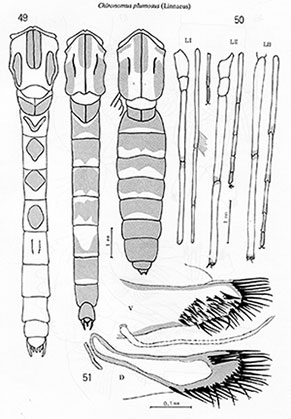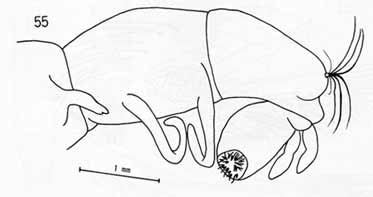Chironomus suwai Golygina and Martin 2003Adult and Pupa: Described by Sasa (1978) as C. plumosus. Adult: Normally dark, but also a lighter form. In darker form the thorax is grey, with dark grey scutal stripes, scutellum brown and postnotum dark brown; abdomen largely black or dark brown with narrow caudal pale bands, the dark areas on tergites II-IV have a median caudal projection. In the pale forms the scutal stripes are brown and the ground color yellow; with the abdomen the tergites are largely yellow, with a diamond shaped central dark area on segments II-IV. Wing length about 7.0 mm, posterior margin markedly concave at the end point of Cu(2)(also in female). Cross vein colored. AR about 5.4. Frontal tubercles oval in shape, 45x29 µm. Palp proportions (segments 2-4)(micron) 120 : 310: 260 : 410 ; P5/P4 = 1.58; P5/P3 = 1.32. Legs generally yellow, with dark knee joints, more conspicuous on fore legs; tarsi I-IV dark on distal 4/5, tarsus V completely dark. LR 1.2-1.3, beard conspicuous, BR 6.5. Leg lengths (micron) and proportions:
Posterior edge of tergite IX is flat, anal point is slender, apically expanded. Superior volsella closest to E(g) type of Strenzke (1959). Gonstylus narrows relatively sharply over posterior quarter.  Adults (upper) and pupal spurs (below: 51 V & D) from Sasa 1978 (as C. plumosus) Coloration also variable, the pale form having lighter ground color and the apical pale areas on the abdominal tergites are larger. Antennal proportions (micron) 230 : 140 : 180 : 150 : 340. AR 0.49; A5/A1 1.47; Frontal tubercles 45 x 26 µm.Leg lengths (micron) and proportions
Pupa: Notes only that the caudolateral spur is unusual in that it has numerous short spines (see Fig. V & D above) rather than the longer apical spines of most species. Fourth instar larva: A medium to large plumosus type (length about 21.2-26.2 mm)(fem 24.2-26.2; m 21.2-22.5), anterior VT generally longer (ant. 1.41 (1.20-1.88); post. (1.20-1.80) mm; lateral tubules from 280-380 µm; anal tubules about 685-735 µm and 2.7-2.9 times longer than wide. Gula darkened on posterior 2/3 with scalloped anterior margin. Oesophageal opening about 92 (78-106) µm wide and 3.3 (2.4-4.2) times wider than deep.  Posterior end of C. suwai larva (C. plumosus of Sasa 1978) Ventromental plates with jagged edge as in C. plumosus; separated by about 0.37-0.42 of the mentum width; about 270 µm wide and 4.0-4.4 times wider than deep and about same width as the mentum; about 82 (77-91) striae; VMR about 0.33. Pecten epipharyngis (Fig. a) with about 13.7 (11-15) broad teeth (type B). Distance between the antennal bases greater than that between the S4 setae which are separated by about 76% of the frontoclypeal width at that point.Antenna (fig. b) with segment A1 about half of VHL and about 2.9-3.8 longer than wide (lower value may be due to squashing of the segment during slide mounting), RO about a third to almost halfway up from base of segment; AR about 2.71-2.81, segment proportions (micron) 211 : 41 : 13 : 15 : 8. Premandible not visible in most available specimens but one specimen had inner tooth 3.25 times the width of the outer tooth. Mandible (Fig. d) with third inner tooth well separated and darkened (type IIIC), about 28.7 (27-30) furrows on outer surface at the base; 12.75 (12-14) setae in Pecten mandibularis; Mdt-Mat about 35 µm, MTR 0.33. Cytology: Four polytene chromosomes with the thummi-cytocomplex combination: AB, CD, EF, G. suwA1: 1 - 2c, 10 - 12a, 13ba, 4a-c, 2g-d, 9 - 4d, 2h - 3, 12cb, 13c - 19 Found: Type locality - Lake Suwa, Honshu, JAPAN. |
Revised: 11 April 2025
Access: Unrestricted
Copyright © 2018-2025, Jon Martin.